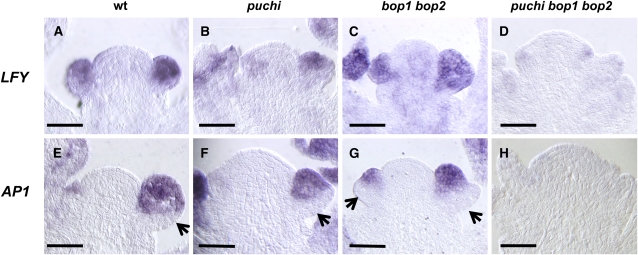Figure 7.
Expression of the Floral Meristem Identity Genes LFY and AP1 in the puchi bop1 bop2 Mutant.
(A) to (H) Longitudinal sections hybridized with either a LFY or an AP1 probe.
(A) The wild-type inflorescence apex hybridized with the LFY probe.
(B) The puchi-1 inflorescence apex hybridized with the LFY probe.
(C) The bop1-4 bop2-11 inflorescence apex hybridized with the LFY probe.
(D) The puchi-1 bop1-4 bop2-11 inflorescence apex hybridized with the LFY probe. Note that compared with the wild type (A), LFY expression does not change in puchi single (B) or bop1 bop2 double (C) mutants but is markedly reduced in the puchi bop1 bop2 triple mutant (D).
(E) The wild-type inflorescence apex hybridized with the AP1 probe.
(F) The puchi-1 inflorescence apex hybridized with the AP1 probe.
(G) The bop1-4 bop2-11 inflorescence apex hybridized with the AP1 probe.
(H) The puchi-1 bop1-4 bop2-11 inflorescence apex hybridized with the AP1 probe. Note that compared with the wild type (E), AP1 expression is detected in a much smaller proportion of the adaxial cells of young flower primordia of puchi single (F) and bop1 bop2 double (G) mutants and is almost undetectable in the puchi bop1 bop2 triple mutant (H).
Arrows indicate the absence of AP1 expression on the abaxial side. Bars = 50 μm.

